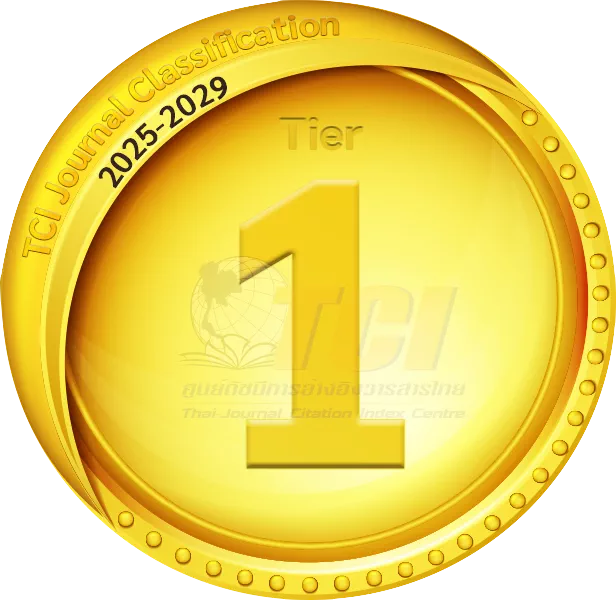A Study on the Driving Factors of Satisfaction and Continuous Intention to Use Online Learning Among Vocational Students in China
DOI:
https://doi.org/10.14456/shserj.2025.24Keywords:
Techincal Readiness, Self-Efficacy, Experience, Learning Satisfaction, Continuous IntentionAbstract
Purpose: This study aims to explore the factors influencing the online learning satisfaction and continuous intention of the students majoring in folk music and dance at Rongjiang Secondary Vocational School, China. The research framework included seven variables: teachers’ technical readiness students’ technical readiness, self-efficacy, autonomy, quality of learning experience, learning satisfaction, and continuous intention. Research design, data, and methodology: The questionnaire was used to collect 500 sample data from the target population in this study. Purposive, quota, and convenience sampling were adopted. Before distributing the questionnaire, item-objective congruence (IOC) and a pilot test of Cronbach’s Alpha were adopted to test the content's validity and reliability. The data were analyzed by confirmatory factor analysis and structural equation models to verify its fit and determine the causal relationship between variables. Result: The results show that the six hypotheses are supported. Teachers’ technological skills, students’ technical skills, students’ self-efficacy, students’ autonomy, and quality of learning experience significantly impact learning satisfaction. Learning satisfaction has a significant impact on continuous intention. Conclusions: To guarantee a high rate of learner engagement and satisfaction with e-learning, policymakers, practitioners, and educators should consider crucial variables such as offering efficient communication, innovative online courses, and training for existing and new users.
References
Abedin, M., Islam, M. A., Rahman, F. N., Reza, H. M., Hossain, M. Z., Hossain, M. A., & Hossain, A. (2021). Willingness to vaccinate against COVID-19 among Bangladeshi adults: Understanding the strategies to optimize vaccination coverage. PloS one, 16(4), e0250495.
Arbuckle, J. L. (1995). Amos 4.0 User’s Guide. SmallWaters Corporation.
Badri, M. (2013). Abu Zayd al-Balkhi’s Sustenance of the Soul: The Cognitive Behavior Therapy of a Ninth Century Physician. The International Institute of Islamic Thought.
Bandura, A. (1997). Self-efficacy: The exercise of control (1st ed.). W H Freeman/Times Books/ Henry Holt & Co.
Barbera, E., Clarà, M., & Linder-Vanberschot, J. (2013). Factors Influencing Student Satisfaction and Perceived Learning in Online Courses. E-Learning and Digital Media, 10(3), 226-235. https://doi.org/10.2304/elea.2013.10.3.226
Baya’a, N., & Daher, W. (2009). Learning mathematics in an authentic mobile environment: The perceptions of students. International Journal of Interactive Mobile Technologies, 3, 6-14. https://doi.org/10.3991/ijim.v3s1.813
Benson, P. (2001). Teaching and Researching Autonomy in Language Learning (1st ed.). Longman.
Chandler, H. M. (2009). The Game Production Handbook. Jones & Bartlett Publishers.
Chang, C. (2012). Narrative Ads and Narrative Processing. In E. Thorson and S. Rodgers (Eds.), Advertising Theory (pp.241-254). Routledge.
De la Torre-Cruz, M. J., García-Linares, M. C., & Casanova-Arias, P. F. (2014). Relationship between parenting styles and aggressiveness in adolescents. Electronic Journal of Research in Educational Psychology, 12(1), 147-169. https://doi.org/10.14204/ejrep.32.13118
Dele-Ajayi, O., Strachan, R., Anderson, E., & Ayodele, V. (2019). Technology-Enhanced Teaching: A Technology Acceptance Model to Study Teachers’ Intentions to Use Digital Games in the Classroom. IEEE Frontiers in Education Conference, 1-8.
Fornell, C., & Larcker, D. F. (1981). Evaluating structural equation models with unobservable variables and measurement error. Journal of Marketing Research, 18(1), 39-50.
https://doi.org/10.1177/002224378101800104
Godwin, J. (2011). Immobilized Mediator Electrodes for Microbial Fuel Cells [Unpublished Master’s Thesis]. University of Saskatchewan, Saskatoon.
Gray, J. (2017). Zoo ethics: The challenges of compassionate conservation (1st ed.). Csiro Publishing.
Hair, J., Black, W., Babin, B., Anderson, R., & Tatham, R. (2006). Multivariate Data Analysis (6th ed.). Pearson Prentice Hall.
Hatlevik, I. (2018). Examining the Relationship Between Teachers’ ICT Self-Efficacy for Educational Purposes, Collegial Collaboration, Lack of Facilitation, and the Use of ICT in Teaching Practice. Frontiers in Psychology, 9, 935. https://doi.org/10.3389/fpsyg.2018.00935
Hatlevik, O. E., Tømte, K., Skaug, J. H., & Ottestad, G. (2013). Monitor 2010. Oslo: Senter for IKT i utdanningen, 1(2) 1-194.
Henri, D. C., Morrell, L. J., & Scott, G. W. (2018). Student perceptions of their autonomy at university. Higher Education, 75, 507-516. https://doi.org/10.1007/s10734-017-0152-y
Hung, M. L., Chou, C., Chen, C. H., & Own, Z. Y. (2010). Learner readiness for online learning: Scale development and student perceptions. Computers & Education, 55(3), 1080-1090.
https://doi.org/10.1016/j.compedu.2010.05.004
Kariyev, B. E., Fishman, Y. N., Agranovich, O. A., & Fokina, L. E. (2015). Teacher professional development: International perspectives. Coddy School, 378(12), 1-18.
Koka, A., & Hagger, M. S. (2010). Perceived teaching behaviors and self-determined motivation in physical education: A test of self-determination theory. Research quarterly for exercise and sport, 81(1), 74-86. https://doi.org/10.1080/02701367.2010.10599630
Kong, C. K. (2008). Classroom learning experiences and students’ perceptions of quality of school life. Learning Environments Research, 11(2), 111-129. https://doi.org/10.1007/s10984-008-9040-9
Long, R. G., Torre, O. M., Hom, W. W., Assael, D. J., & Iatridis, J. C. (2016). Design requirements for annulus fibrosus repair: review of forces, displacements, and material properties of the intervertebral disk and a summary of candidate hydrogels for repair. Journal of biomechanical engineering, 138(2), 021007. https://doi.org/10.1115/1.4032353
Mackey, A., Oliver, R., & Leeman, J. (2003). Interactional Input and the Incorporation of Feedback: An Exploration of NS-NNS and NNS-NNS Adult and Child Dyads. Language Learning, 53(1), 35-66. http://dx.doi.org/10.1111/1467-9922.00210
Malhotra, N., Kim, S., & Patil, A. (2006). Common Method Variance in IS Research: A Comparison of Alternative Approaches and a Reanalysis of Past Research. Management Science, 52(12), 1865-1883. https://doi.org/10.1287/mnsc.1060.0597
Marks, D. F., Murray, M., Evans, B., Willig, C., Woodall, C., & Sykes, C. M. (2005). Health psychology: Theory research, and practice (2nd ed.). Sage.
Mohammadi, H. (2015). A Study of Mobile Banking Usage in Iran. International Journal of Bank Marketing, 33, 733-759. https://doi.org/10.1108/IJBM-08-2014-0114
Olivier, T. A., & Shapiro, F. (1993). Self-efficacy and computers. Journal of Computer-Based Instruction, 20, 81-85.
Parasuraman, A. (2000). Technology Readiness Index (TRI) a multiple-item scale to measure readiness to embrace new technologies. Journal of service research, 2(4), 307-320. https://doi.org/10.1177/109467050024001
Pedroso, C. B., Silva, A. L., & Tate, W. L. (2016). Sales and Operations Planning (S&OP): insights from a multi-case study of Brazilian organizations. International Journal of Production Economics, 182, 213-229. http://dx.doi.org/10.1016/j.ijpe.2016.08.035.
Peltier, J., Hay, A., & Drago, W. (2005). The Reflective Learning Continuum: Reflecting on Reflection. Journal of Marketing Education - J Market Educ, 27(3), 250-263.
https://doi.org/10.1177/0273475305279657
Peltier, J. W., Drago, W., & Schibrowsky, J. A. (2003). Virtual communities and the assessment of online marketing education. Journal of Marketing Education, 25(3), 260-276.
https://doi.org/10.1177/0273475303257762
Reeves, T. D., & Li, Z. (2012). Teachers’ technological readiness for online professional development: evidence from the US e-Learning for Educators initiative. Journal of Education for Teaching, 38(4), 389-406. https://doi.org/10.1080/02607476.2012.707921
Saidur, R., Leong, K. Y., & Mohammed, H. A. (2011). A review on applications and challenges of nanofluids. Renewable and sustainable energy reviews, 15(3), 1646-1668.
Saprikis, V., Vlachopoulou, M., & Markos, A. (2021). Modelling consumers' payment behaviour towards contactless cards. International Journal of Business Information Systems, 38(3), 393. https://doi.org/10.1016/j.rser.2010.11.035
Schunk, D. H. (1991). Self-efficacy and academic motivation. Educational psychologist, 26(3-4), 207-231. https://doi.org/10.1080/00461520.1991.9653133
Sica, C., & Ghisi, M. (2007). The Italian versions of the Beck Anxiety Inventory and the Beck Depression Inventory-II: Psychometric properties and discriminant power. In M. A. Lange (Ed.), Leading-edge psychological tests and testing research (pp. 27–50). Nova Science Publishers.
Straub, D. W. (1989). Validating instruments in MIS research. MIS Quarterly, 13(2), 147-169. https://doi.org/10.2307/248922
Strong, R., Wynn, T. J., & McCleur, M. M. (2012). Investigating students’ satisfaction with eLearning courses: the effect of learning environment and social presence. Journal of Agricultural Education, 53(3), 98-110. https://doi.org/10.5032/jae.2012.03098
Su, Y.-L., & Reeve, J. (2011). A Meta-Analysis of the Effectiveness of Intervention Programs Designed to Support Autonomy. Educational Psychology Review, 23, 159-188.
https://doi.org/10.1007/s10648-010-9142-7
Sumsiripong, P. (2016). The impact of learning organization and competitive advantage on organizational performance in SMEs (Thailand): an empirical study.
http://repository.nida.ac.th/handle/662723737/3993.
Taylor, I. M., & Ntoumanis, N. (2007). Teacher motivational strategies and student self-determination in physical education. Journal of Educational Psychology, 99(4), 747-760. https://doi.org/10.1037/0022-0663.99.4.747
Van Dinther, M., Dochy, F., & Segers, M. (2011). Factors affecting students’ self-efficacy in higher education. Educational research review, 6(2), 95-108. https://doi.org/10.1016/j.edurev.2010.10.003
Volery, T., & Lord, D. (2000). Critical success factors in online education. International journal of educational management, 14(5), 216-223. https://doi.org/10.1108/09513540010344731
Vonderwell, S. (2003). An examination of asynchronous communication experiences and perspectives of students in an online course: A case study. The Internet and higher education, 6(1), 77-90. https://doi.org/10.1016/s1096-7516(02)00164-1
Wanichbancha, K. (2014). Statistical Analysis: Statistic for Busi ness and Research. Chulalongkorn University Press.
Wiers-Jenssen, J., Stensaker, B., & Grogaard, J. B. (2002). Student Satisfaction: Towards an empirical deconstruction of the concept. Quality in Higher Education, 8(2), 183-195.
Xia, Y., & Yang, Y. (2019). RMSEA, CFI, and TLI in structural equation modeling with ordered categorical data: The story they tell depends on the estimation methods. Behavior Research Methods, 51(1), 409-428. https://doi.org/10.3758/s13428-018-1055-2
Zheng, Y., Zhao, K., & Stylianou, A. (2013). The impacts of information quality and system quality on users’ continuance intention in information-exchange virtual communities: An empirical investigation. Decision support systems, 56, 513-524. https://doi.org/10.1016/j.dss.2012.11.008
Downloads
Published
How to Cite
Issue
Section
License
Copyright (c) 2025 Xin Zhao

This work is licensed under a Creative Commons Attribution 4.0 International License.
The submitting author warrants that the submission is original and that she/he is the author of the submission together with the named co-authors; to the extend the submission incorporates text passages, figures, data, or other material from the work of others, the submitting author has obtained any necessary permission.
Articles in this journal are published under the Creative Commons Attribution License (CC-BY What does this mean?). This is to get more legal certainty about what readers can do with published articles, and thus a wider dissemination and archiving, which in turn makes publishing with this journal more valuable for you, the authors.




